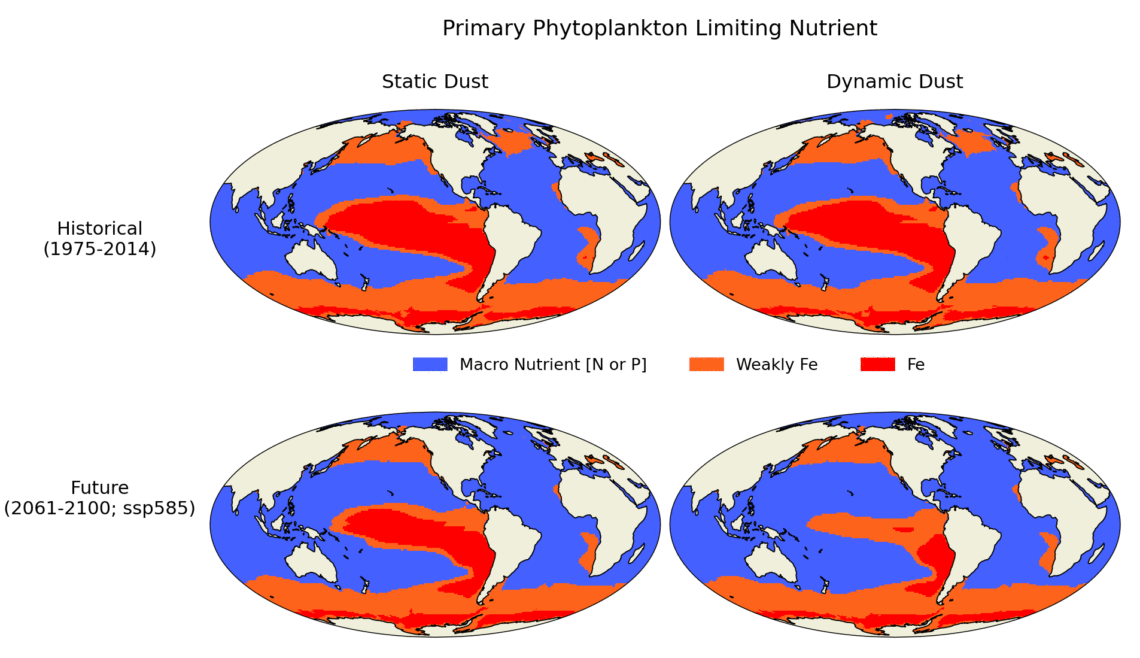December 22nd, 2023
Key Findings
- The authors used GFDL’s Earth system model, ESM4.1, to explore climate-driven changes in the deposition of dust and iron from the atmosphere to the ocean under a range of climate change scenarios.
- Projected end-of-21st-century increases in central tropical Pacific dust and iron deposition strengthen with increasing emissions/radiative forcing, and are aligned with projected soil moisture decreases in adjacent land areas and precipitation increases over the equatorial Pacific.
- ESM4.1 incorporation of “dynamic” dust deposition from the atmosphere to the ocean permits variability in deposition drivers (such as atmospheric dust concentration and precipitation) to affect projections of upper ocean biogeochemistry, specifically driving shifts in phytoplankton nutrient limitation in the central Pacific.
- Primary production and particulate organic carbon flux are enhanced in the central-to-eastern equatorial Pacific, and reduced off the equatorial Pacific, under dynamic vs. static dust deposition.
Liz Drenkard, Jasmin John, Charlie Stock, Hyung-Gyu Lim, John Dunne, Paul Ginoux, and Jessica Luo. Geophysical Research Letters. DOI: 10.1029/2022GL102058
Projections of future nutrient limitation and primary production have implications for fisheries management. The authors used GFDL’s Earth system model, ESM4.1, to explore climate-driven changes in the deposition of dust and iron from the atmosphere to the ocean under a range of climate change scenarios, in an attempt to understand where the “fish food” is going to be and why.
These simulations employed a dynamic approach for iron deposition, reflecting changing atmospheric dust loads, and factoring in wind and precipitation, which affect dust and iron transfer from the atmosphere to the ocean. Under increasing climate change scenarios, ESM4.1 projects drier soil conditions, as well as more dust in the atmosphere and precipitation over the Pacific Ocean toward the end of the 21st century. Elevated levels of future iron delivery to the ocean reduce iron limitation of phytoplankton growth in the central Pacific.
As a result, higher levels of phytoplankton production are found in the central, equatorial Pacific, but lower levels downstream in the western and off-equatorial Pacific because other nutrients necessary for growth are depleted by reduced upwelling and enhanced production in the eastern Pacific. This geographic pattern also appears in the change in carbon sinking from the surface ocean to depth. Overall, these results highlight how Earth System Model advances can improve our understanding of climate change impacts on marine ecosystems.
ESM4.1 is one of only a few models submitted to CMIP6 that implement dynamic dust deposition to the ocean. This coupling of biogeochemical processes advances our forecasting capacity by implementing a more holistic representation of the earth system. The authors show that the projected, sharper gradients in foundational marine food chain variables across the Pacific are partially due to how dust/iron deposition is implemented in Earth system models.



